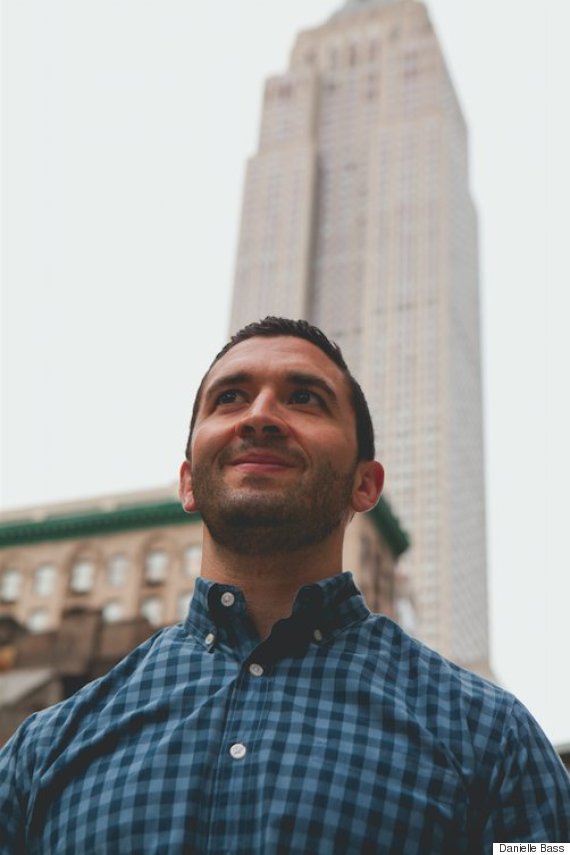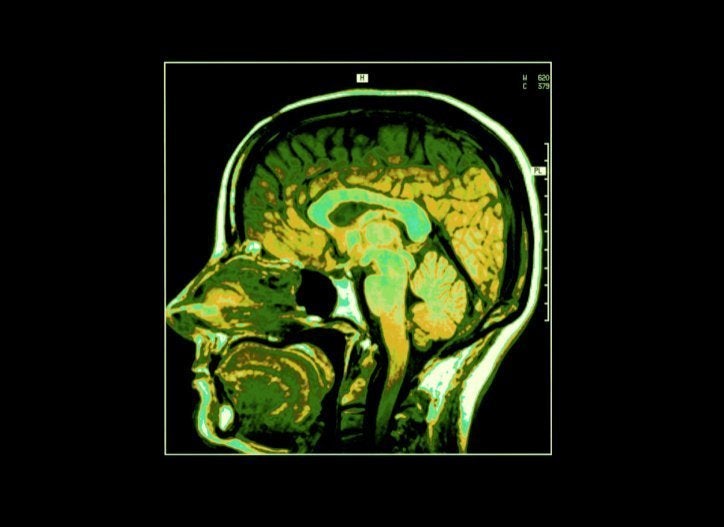A 500-square-foot Midtown studio in New York City is quietly becoming a temple for the anxious, the overworked and the curious. There are 26 seats.
From inside the studio windows, you peer over taxi cabs crowding 5th Avenue below and if you put your nose right up to the glass, you can see the needle of the Empire State building looming large, piercing upward into the sky.
Ben Turshen opened the single door to his meditation studio less than six weeks ago and he has only been teaching the practice for two years. But his following is growing, perhaps because he’s the most unlikely of teachers.
“I didn’t learn meditation to become a meditation teacher. That’s for sure. I did it to help me survive,” Turshen told The Huffington Post over the phone last week.
Reared in New York City and then in Westchester County, Turshen, now 34, says he struggled under the perpetually crippling fog of anxiety, depression and insomnia for most of his life. As a child, he struggled with sleep and struggled to learn to read. He was a great practice player in sports but couldn’t perform to his greatest ability in games.
His work ethic and supportive family proved enough of a force to push him to succeed in athletics, finish undergrad at Boston University magna cum laude, and go on to graduate school at Columbia University and then law school at St. John’s University. But he reached a breaking point.
“The level of demand that I was facing as a first year law student was greater than my capacity to adapt,” Turshen said. “The way I had coped before just wasn’t working. I went to my doctor and said ‘I’m walking around miserable, having panic attacks and I can’t sleep at night. What can I do?’ My doctor took out a notepad and started writing down prescriptions.”
Turshen was 24-years-old. He'd never been medicated before. Since he felt he was truly suffering, however, he agreed to the regimen. “I would take my Ambien and be knocked out. I would be unconscious -- you could call that sleep, I suppose. I would take my Adderall and was able to focus. But my Adderall made me anxious and my Ambien made me feel hung over the next day. My antidepressants were working minimally. If I had a panic attack, I would take a Xanax and I would feel relaxed, but it wasn’t a natural feeling. None of it felt natural. I didn’t feel like myself anymore.”
He tried to get used to this way of life while studying extra hours in the library, but Turshen eventually returned to his doctor to see what he could do in addition to taking his medication. That’s how he found himself in a therapist’s chair talking about spirituality.
Turshen was surprised when, after a series of questions, his new therapist asked him what his spiritual practice was. Though Turshen was raised Jewish, he stumbled and started talking about religion. The therapist stopped him. This isn’t about religion, he said. He asked again: “What is your spiritual practice?”
When Turshen couldn’t answer, the therapist suggested he learn how to meditate. “I thought my mind was too crazy for it,” Turshen remembers thinking. “I had this preconceived idea that meditation was something for monks. In my mid-twenties I was anything but a monk,” he said, laughing.
But as he continued through sleepless nights, classes and the haze of all the drugs he was on, Turshen made his way to a Buddhist meditation center in New York City. It was not a match made in heaven. He listened to the instructions and said he felt incredibly uncomfortable. “My mind was doing everything but being still.”
When the class ended, Turshen introduced himself as a beginner to the teacher and asked how long it typically takes to get some mastery over the practice. “His answer was very discouraging,” Turshen said. “He said it takes a lifetime to enlightenment.” He walked out of the center more anxious than when he had arrived. “I thought this is my life: medication and therapy.”

Over the next three years, he completed law school and passed the bar exam. Turshen told himself that once he started working at a law firm, he would settle into his adult life and maybe his anxiety and depression would become more manageable.
But it was the exact opposite: Everything got harder. His job working in the corporate department of a prestigious law firm had Turshen dealing mostly with mutual funds and hedge funds when the market crumbled before his eyes in 2008. “I decided on my own that I just couldn’t up my dose on any of my medications. I needed to find a sustainable way to manage my anxiety and depression -- I didn’t want to spend the rest of my life on drugs,” he said.
So he went back to meditation, despite his past experience. He began to investigate mindfulness and relaxation techniques online and even went to some classes.
But nothing had a lasting effect until he found a practice called Vedic meditation. He tracked down a teacher and signed up for a four-session introductory course. “Everything changed from the moment I learned,” Turshen said.
He ended up staying on his medication for about one year after learning to meditate, and stayed in therapy for four more years. He says he eventually felt healthy enough to stop taking his drugs.

The studio at Ben Turshen Meditation in Midtown.
Vedic meditation is a mantra-based practice similar to Transcendental Meditation and is believed to go back many thousands of years. A mantra is used to help your mind settle into what Turshen and Vedic teachers call “that least excited state” or “an inner, silent consciousness state.”
The practice has ties to ancient India. "Vedas" are the earliest Hindu scriptures written in Sanskrit. They are made up of hymns, philosophy, and guidance for the priests of the Vedic religion. But today, Vedic meditation does not have to be a religious practice.
"The experience that we have using the meditation technique is a spiritual experience. It’s not a religious experience," Turshen said. "You don’t have to subscribe to any type of philosophy. In fact, if you’re a complete skeptic, it still works. If you’ve been taught properly, then the change that occurs in your physiology when you meditate will happen whether you believe in it or not. Your mind settles down to that least excited state and your body settles with it.”
A mantra is used as a tool to help your mind get into that least excited state. In the Vedic tradition, your teacher presents you with your personal mantra during a private ceremony and you use that mantra in your meditation going forward. The mantra is not meant to have any meaning. In fact, it's thought of more as a sound that is pleasing to repeat over and over again in your mind as you meditate. The goal isn't to focus on the mantra, but to use it as a way to get into your zone.
"The mantra does the work for us," Turshen explained. "It attracts and distracts the mind away from all of the other thoughts. They are critical to this process. We can’t force the mind to get to that quiet place. But the mantra helps that happen."
Turshen remembers coming home after his first class and feeling a sense of calmness that he didn’t even recognize at the time.
He took his Ambien that night to be safe, unsure of how long the feeling would last. Yet the next night, he came home and felt the same way. “Relaxed and at ease,” he said.
Evenings were the worst time of day for him. His anxiety would peak as he spent those few hours along in his apartment before bed.
“The moment I would lie horizontal in bed is when it would get really bad, “ he said. “What would happen the next day? It all felt like the end of the world was going to happen, and of course it never did.”
By the third night of his Vedic meditation course, Turshen was ready to experiment. He put an Ambien on the bedside table and told himself that if he was awake in one hour, he would take it. He fell asleep within minutes and slept through the night.
Turshen said he has been sleeping that way ever since. He believes that meditation instantly cured his insomnia. He continued his daily practice and started to notice all other sorts of changes in his life, too. He began performing better at work and says he was more productive and confident. He noticed that he wasn’t getting sick all the time. The days of being in between some version of a head cold, flu, sore throat and sinus infection became less and less frequent.
His relationships began to improve. “My stress started to dissipate,” he said. “When you think about the most nervous, anxious people in your life, as much as you love them, you don’t want to be around them. That was me. I got happier and it made everyone else want to be around me.”
Turshen’s response to meditation this time around was nothing short of transformative. He began to look at his life with deeper clarity, he says, and noticed patterns and behaviors that he wanted to change.

Two years later, he made the biggest change yet.
He decided to leave his career as an attorney behind and train to become a meditation teacher instead. He enrolled in the Vedic meditation teacher’s training and worked full-time as a cycling instructor at the chic studio SoulCycle to pay the bills. For the next two years, he read Sanskrit, learned how to perform the Vedic ceremony and spent countless hours meditating himself.
When he finished his training and begin teaching, he rented a space in a yoga studio in Chelsea. He soon outgrew it and decided it was time to open his own studio.
“I had tremendous trepidation about leaving my legal career,” he said. So many people asked him how he could leave such a great job and all that money. “It’s very easy to get stuck and to do the safe thing. To do the thing that’s expected,” he said. “But I came to realize that I wasn’t going to gain all that much fulfillment from being an attorney. What meditation gave me was clarity and adaptability to change my life. Because I saw this transformation in myself, I wanted to give that experience to my friends, my family and my community. I really became inspired to become a teacher.”
While meditation worked for Turshen, for many, medication and meditation together are a powerful combination. And for many still, medication is the difference between life and death.
“I am only here because I had those experiences,” Turshen said. “I wouldn’t have become a meditation teacher if I didn’t have that high level of stress crippling me.” He is particularly fond of the Steve Jobs quote, “You can't connect the dots looking forward, you can only connect them looking backwards.”
“The only thing that we can ever count on in life,” Turshen said, “is that time is going to go by and that things are going to change.”
Unlike his first experience with meditation, Turshen has come to believe that meditation doesn’t involve eliminating all thoughts.
“The meditation technique that I teach takes the mind to that state beyond thought. When it happens, we don’t know it happens,” he said. “The mantra slips away and at times there are no thoughts replacing the mantra. We forget that we’re meditating while we are meditating.”
Classes at Ben Turshen Meditation in New York City are booked for May and June. They are adding sessions to meet the demands. Turshen also teaches in Westchester County every couple of months and travels to his wife’s hometown of Wooster, Ohio to teach meditation a few times a year.

